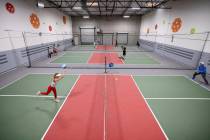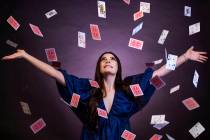A Safe Space for Violence
He looks like the product of 10,000 pushups and twice as many bad days, this scowling, screaming heel. “Quit, Sandra! Quit!” The command roars from the jacked dude, his chest and anger bared in unison. Trapped in his arms: a woman in pink whose limbs are being pulled in directions that limbs were never meant to be pulled. Sweat and desperation pool in the creases of her brow.
G Sharpe has victory firmly — very firmly — in hand. Hours earlier, backstage at the Vegas Theatre Company, the wrestling villain had explained the motivation behind his character: “G Sharpe is just a hostile person who likes to take — because he feels like the world has taken, taken, taken from him and given absolutely nothing back. I want you to feel the misery and the pain that I went through. So, I’m going to go out there, and I’m going to hurt somebody.”
Tonight, that somebody is Sandra Moone, the 21-year-old champion and face of PrideStyle Pro Wrestling, an upstart league that debuted in 2021. She’s making her 11th title defense on this Saturday evening in March, putting her belt on the line against perhaps her most formidable challenger yet, an accomplished grappler who’s fought around the world, from Germany to China to Canada, where he wrestled the night before.
Their match is notable for several reasons: It’s rare for the champ of any wrestling league to be a woman. It’s rarer still for her to be openly pansexual. Taking things even further on the rare-o-meter: She’s competing against a man in the main event.
The bout serves as an encapsulation of what PrideStyle is all about: affording an equal to opportunity for a good ol’-fashioned pummeling to anyone, regardless of gender, size, shape or sexual orientation. 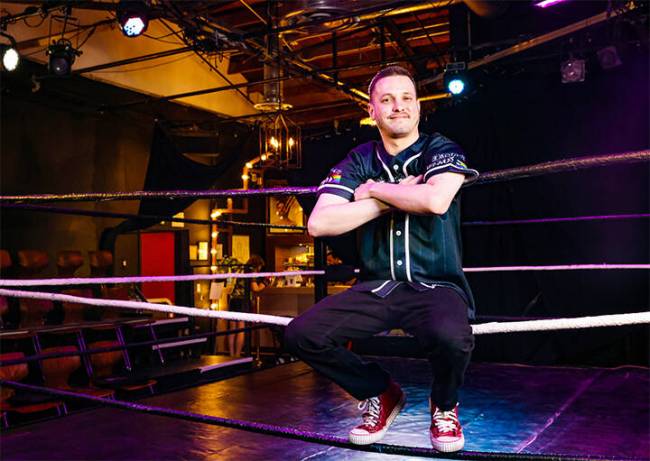
“We bill PrideStyle as inclusive pro wrestling,” says Milhouse Malott, PrideStyle’s founder and leader. “We book pro wrestlers against pro wrestlers. Whatever your sexual identification or your gender identification is, it’s not important to what you can do in the ring.”
With a voice that booms like a detonated landmine, ring announcer Diana Montes Sandoval — who also happens to be G Sharpe’s girlfriend — spells things out loud and clear at the beginning of the show. “For those of you who don’t know,” she begins, “let me remind you: No racists here.”
“No!” bellows the crowd in response.
“No sexists.”
“No homophobes.”
“And absolutely no bigots here.”
“This is PrideStyle,” she says. “We are a safe space for violence.”
About that violence: G Sharpe’s not done unleashing it. The packed house is going wild, cheering, chanting — “This is awesome! This is awesome!” Feet stomp in a bleacher-rattling rhythm. Amid all the idealism and equality and warm and fuzzy stuff: a knee to Sandra Moone’s face.
This is wrestling, you know. Tonight, a guy with a bleeding forehead will empty a coffee cup full of thumb tacks into the ring. He will also roll a bowling ball into another man’s groin. Someone will bellow from the crowd: “Pick up a spare!” 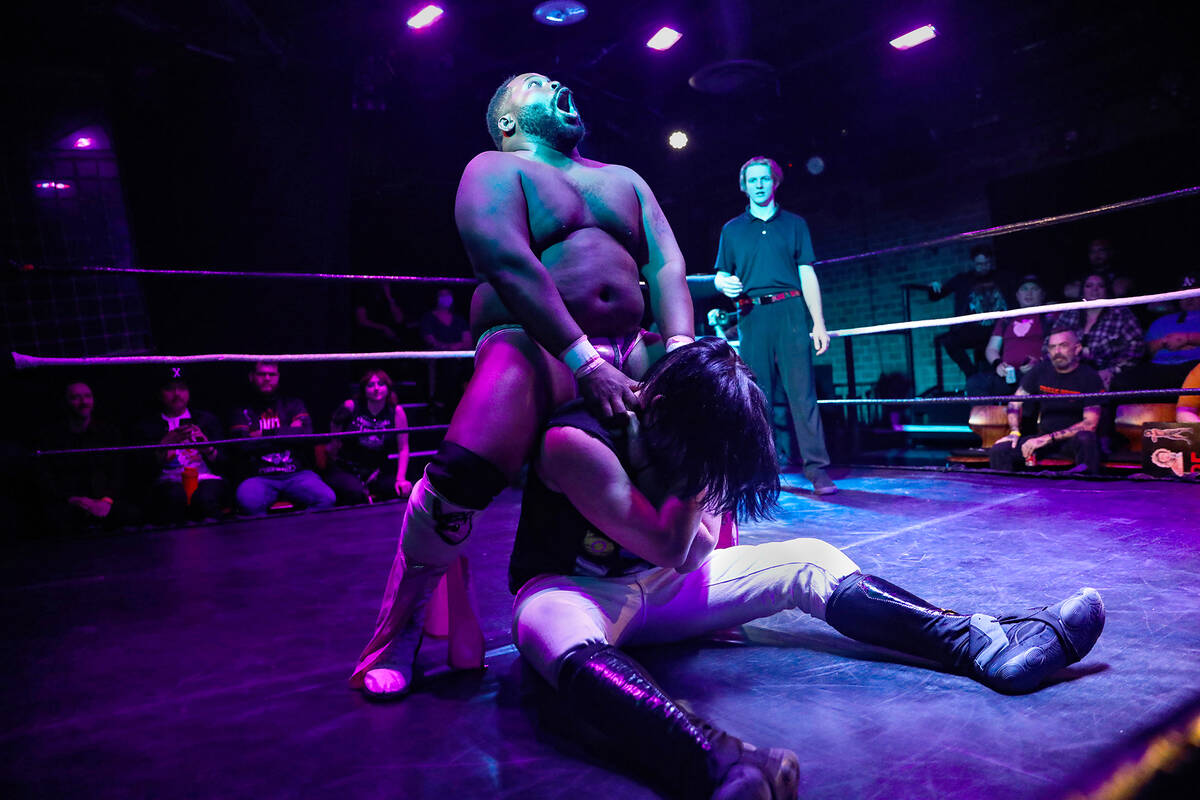
Backstage before showtime, wrestlers lug suitcases full of gear, rehearse lines of dialog — “Do it again, big boy!” “Whose side are you on?!” — while choreographing moves for the ballet of beef soon to commence.
“When we’re going, just kill me,” instructs 15-year-old grappler Bodhi Young Prodigy to a pair of competitors sporting black metal-style corpse paint. “We’re just gonna go double drop-kick, hockey fight, we each get a falsie, then kill me.”
Weaving through the fray is Malott, the conductor of all of tonight’s chaos and a graphic designer by trade. To hear him tell it, this whole thing began as a goof, really. A few years back, he was hanging with a couple of his fellow wrestling-obsessed friends one night when talk turned to what they would name themselves as a tag-team trio.
“Because it was three queer people, we had the joke of calling it Meat Lovers — like the pizza,” he grins. “We were laughing, and I was like, ‘Who’s gonna promote the Meat Lovers?’ Well, what if we did our own wrestling thing that had a focus on queer wrestlers and minority wrestlers who haven’t got the platform to do something? There’s a whole bunch of really cool local talent here that wasn’t getting any shine or any love in town.”
One such wrestler: Papa Jacé, a polar-bear-sized, 36-year-old ring veteran with a wife and 4-year-old daughter who’s become one of PrideStyle’s biggest attractions after wrestling locally for over a decade. “I’m a pansexual male,” he says. “I have a sibling who is gender fluid; I have a sister who is bisexual — like, this has been my whole life. I know the struggles of being who you are or trying to be who you are in society, and the fact that we had a guy who wanted to start something that just made it a part of the DNA of the company, that meant the world to me.”
PrideStyle wasn’t conceptualized simply as a gay-friendly wrestling league — there are a number of those around the country — but as one where a competitor’s sexuality or gender played no role in who they were pitted against in the ring, a clear break from wrestling’s status quo.
“It wasn’t just going to be the best queer wrestlers wrestling the best queer wrestlers,” Malott says. “That’s great — and there are times on PrideStyle where it is one of the best queer wrestlers versus one of the other best queer wrestlers. But I really wanted to have a space where you knew the best queer wrestler was going to get an opportunity against the best wrestlers — because they were also one of the best wrestlers.”
Tommy Purr remembers being a punchline. The first openly queer wrestling champion in Las Vegas, Purr — aka “The Sin City Kitty” — would often be matched with women because they were dismissively perceived to be a gay’s man equal back in the day. It was comedy relief in spandex; something to chuckle at in between the “real” matches between straight men.
“I’ve had people look at me and go, ‘Well, where can we put Tommy? Put him with the girls,’” he recalls, clad in a white leather jacket in a Vegas Theatre Company dressing room. “‘We don’t have enough girls in the wrestling division, our women’s champion needs someone to face.’ I’m like, ‘Why am I competing for a women’s championship when I’m not a woman?’ ”
Still, Purr — a former actor who describes wrestling as “theater with stunt work” — turned it to his advantage, eventually earning his championship belt against a female competitor in Sinn Bodhi’s Freakshow Wrestling league a little over a decade ago. “I did that with pride,” says Purr, who does, in fact, purr his words, speaking with off-handed flair. “I’m like, ‘Whatever. I’d rather face a talented woman than an irrelevant guy who can’t do anything. Let’s make it work.’ So when I won the belt, and because I’m a diva, they called it the Divas Championship.”
But while Purr was often a fan favorite on the cards he took part in, he was seldom featured in the biggest matches. “Tommy Purr was pretty much always wrestling girls — or managers — never in a main program,” Malott says, “even though he gets extremely great reactions.” Part of the reason Malott created PrideStyle was to give wrestlers like Purr a bigger spotlight against a broader range of opponents — and to do so in a more hospitable environment than they may have been accustomed to. 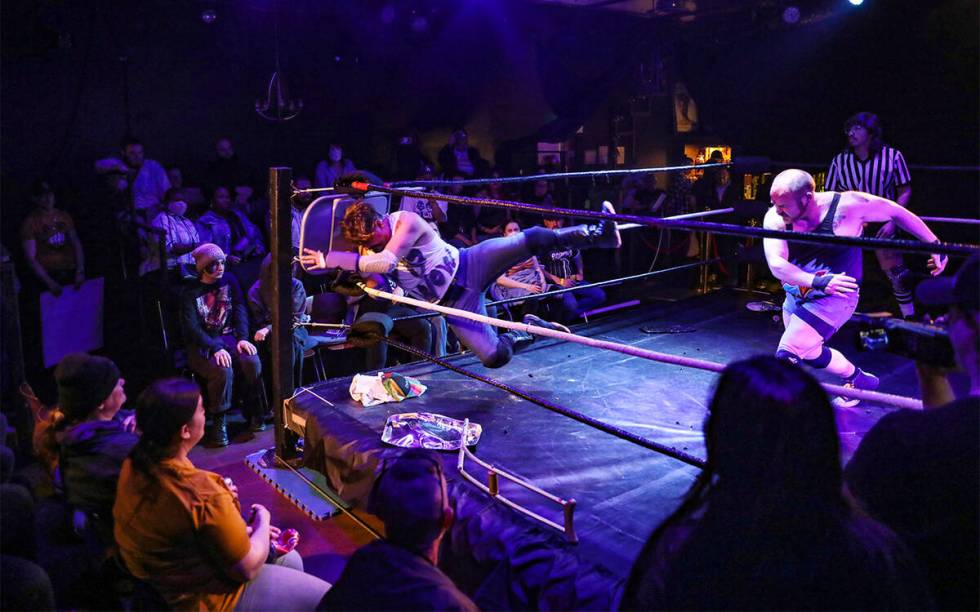
Times have changed for LGBQT+ wrestlers in the past decade, both locally and nationally. In 2013, Darren Young became the first WWE wrestler to come out as gay during a TMZ interview. Two years later, Sonya Deville followed suit as the first lesbian WWE wrestler to publicly acknowledge her sexual identity.
According to the Outsports.com website, there are now over 500 openly gay wrestlers competing worldwide, the top 200 of which are compiled in the annual Queer Wrestling Index 200 (Purr came in at No. 131 in the latest rankings). Still, this doesn’t mean that homophobia is a thing of the past.
“A lot of my gay male friends in the business have experienced being called the F-word, being thrown out of locker rooms or being framed as a predator or predatory to straight male wrestlers,” Purr says. “It’s just disgusting.”
And there’s still the lingering stigma of how gay wrestlers were frequently portrayed as villains or miscreants not that long ago. “Back when I first got started or was just purely watching wrestling, if you had a gay character, most of the time they’re going to be the bad guy,” G Sharpe says. “They were just like, ‘Oh, he’s going to kiss the guy.’ Or, ‘He’s going to kiss me!’ And that was like, ‘Ewwww.’ ”
Queer wrestlers were often expected to carry themselves as peacocking stereotypes. “They would want you to be flamboyant,” Malott says. “For a lot of wrestlers, even in PrideStyle, that’s not important to who their character is.”
When Malott began floating the idea of PrideStyle, he met with some pushback. “A lot of people were like, ‘Well, why don’t we keep that opinion in the back, that way we’re not ostracizing any fans?’ ” Malott says of PrideStyle’s queer-friendly, come-as-you-are ethos. “That was a real stopping point for me. Like, money’s green. But if someone can’t accept me for my sexual identity and who I’m romantically involved with, I don’t really want them to come to my show. I think there’s enough fans out there that we’ll be all right.”
But it took time to find those fans: There were all of 40 of them at PrideStyle’s first show in December 2021. “I probably knew everybody in this crowd,” remembers Sandra Moone, who starred in the main event. 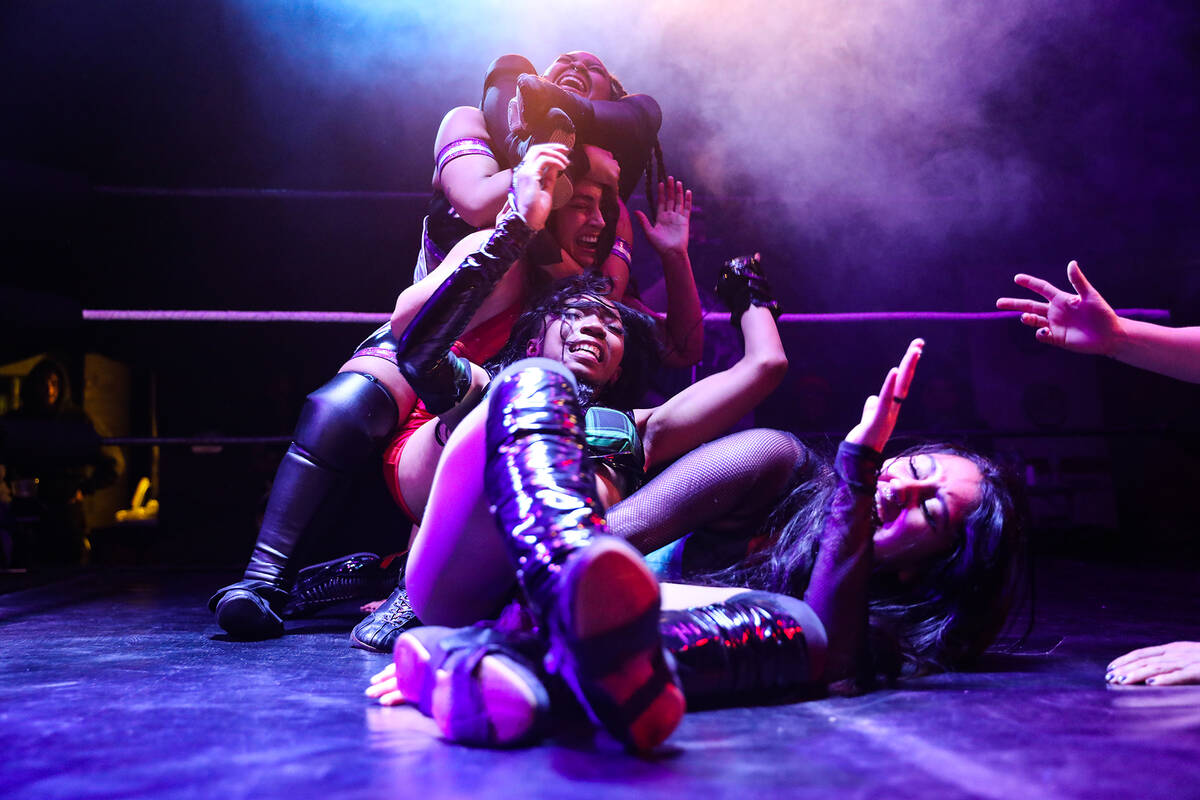
Malott estimates that he lost $700 to $800 that night. The following month, PrideStyle’s draw increased to 55 people. Next time around, they added another five to 10 attendees to the tally. It was slow, but steady growth, a light at the end of the tunnel, if only the lights could be kept on.
“We knew we had something” Malott says, “and it was like, ‘OK, I gotta try to keep water out of the boat long enough to make it to shore.’ ”
Malott’s passion for wrestling dates back to when he was a boy: His earliest memories are of watching WWE Smackdown on an eight-inch TV in his dad’s room. He was particularly fascinated with storylines, arranging fantasy matches in his head, filling notebooks with multishow narrative arcs he’d imagine for his favorite wrestlers — he remembers filling a floppy disc full of Word documents chronicling all these would-be battles.
In 2017, he began training to be a wrestler himself, to become his own storyline. But then he badly broke his leg, enduring a tibial plateau fracture, which impacts the knee agonizingly, like catching a lightning bolt to the patella, requiring surgery. During the healing process, Malott slipped and fell, reinjuring himself. He was off his feet for nearly 16 months. For the first time, he soured on his passion, couldn’t bring himself to watch something he could no longer take part in.
But during the pandemic, Malott relocated here from Oceanside, California, and discovered Vegas’ Versus Pro Wrestling company. He started training again and soon became immersed in the production side of things, helping with the streaming of shows and other behind-the-scenes tasks, learning how to run a company on the fly.
“I was like, ‘Oh, I could do this,’ ” Malott remembers thinking.
So, he did. At Versus’ home base in the Boulevard Mall, he put on PrideStyle’s first shows. A turning point came in June 2022, when the company crowned its first champion: Sandra Moone.
Malott had built a following for Moone show-by-show for six months, matching her with other, largely local wrestlers regularly featured on PrideStyle cards until fans couldn’t wait to see what happened next. That night, the place was packed. “I realized that was what was making the audience grow,” Malott says. “People wanted to see their friends have important matches — so they came to the show. I started to see it turn around where we had no seats left.”
But it wasn’t just the ongoing narratives that kept fans coming back — it was the characters propelling those narratives. Call them the heroes — or heels — next door, wrestlers who sometimes look more like the mailman than “Macho Man” Randy Savage.
Sure, plenty of PrideStyle’s talent bears the chiseled physiques of those who seemingly spend a lifetime at Lifetime Fitness (G Sharpe comes to mind). But unlike the wrestlers you see on prime-time TV or those headlining arenas, where Volvo-sized glutes, quads and traps are as of much of a prerequisite as the ability to take a folding chair to the gut, their indie counterparts come in all shapes and sizes, from thin arms to thick thighs, big pecs to equally big bellies.
Yes, they’ve all put their time in at various wrestling schools in order to develop the skills to orchestrate elaborate moves and take violent, sweat-spraying hits without hurting themselves or others. But what indie wrestling does is afford practically anyone who’s developed those skills a place to display them.
And so maybe you can see yourself in the PrideStyle wrestlers in ways that you never could with The Rock, identifying with their struggles and cheering their efforts to overcome them because you too know what it’s like to be less than perfect.
“You get such an interesting, more raw, more real or more average Joe-type of character that’s more relatable to the fans,” Malott says. “John Cena is amazing, but John Cena is a human brick wall,” he continues. “I don’t think people would look at Papa Jacé necessarily and go, ‘Oh, pro wrestler.’ But then Papa Jacé gets in that ring and is a freak athlete in ways and does things that guys much smaller than him can’t even do well.” 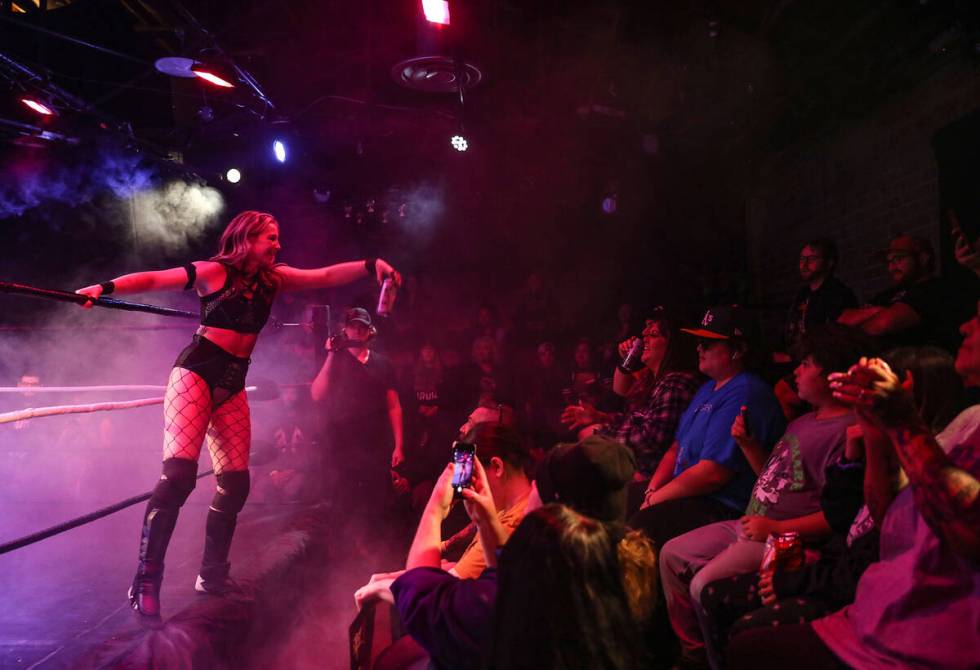
For Jacé, there’s a freedom in being a large man in small pink trunks, which he dons this evening. “I’ve been a little chubby kid my whole life, and going into (wrestling), it’s largely about, ‘You should look a certain way; you should be presented a certain way,” he says. “And so being able to be involved in wrestling as a bigger individual, it’s helped me come out of my shell a lot. Just to go out there, with barely anything on, it’s very liberating.”
"It’s a daisy chain of violence!” So exclaims a man in a red ball cap and shorts seated in the bleachers as five women strangle one other in unison. Soon, the fight spills from the ring into the crowd, fans leaping from their seats to avoid all the flying elbows and airborne fists.
“If the action looks like it’s coming your way — it is,” Montes Sandoval explains to the audience during the show. “Grab your things and move.”
The bout in question is an all-female scramble match, a full-on melee of mascara and muscles. It’s indicative of the evening: Throughout the card, women are featured prominently, with five of the nine matches starring women or people who identify as women.
“If you go to most indie wrestling shows — even still — I’d say the most you will see is one women’s match, maybe two if you’re lucky,” Malott notes. “They’re such a small part of other shows, and they’ve been pigeonholed into that. From a creative standpoint, I was like, ‘If we take these boundaries off, I have all these really real characters.’ ”
From the get-go, one of Malott’s aims with PrideStyle was to incorporate more female wrestlers into the fray — and on equal footing with their male counterparts, a stark contrast to how they were once portrayed.
“When I was growing up, it was a lot of like, ‘They’re the bathroom break,’ ” Montes Sandoval recalls of female wrestling matches and how they were often seen as filler on a show. “It was a little like, ‘It’s not actual wrestling,’ they’re gonna walk around the ring here and there and it’s a bra-and-panties match, so they have to take off their clothes. It was very much male-gaze focused. We’ve gone from that to now, women are in the main event.”
While intergender matches may have been the source of chuckles and eye-rolls in the past, and still seen as a novelty by some, they’re taken seriously here — prioritized, even. “You will never see it on TV, because of societal views and whatever, but having men and women go out there and compete with each other, it elevates women’s wrestling,” contends AJ Aven, PrideStyle’s head of ring crew, who also refs and wrestles as The Black Rose. “It’s all about women.”
To wit, tonight’s show opens with Bryn Thorne — a 21-year-old, clenched-fist-incarnate and self-anointed “Belle of the Brawl” — warring against equally jacked male wrestler Keita with unbridled ferocity. “I like to show that I’m a fighter,” Thorne says. “I let my aggression out; I let my intensity show. It’s an outlet for me to show people what I’m capable of as an athlete.”
Later, popular trans wrestler Dark Sheik battles gay grappler Jai Vidal in the only match of the night where sexual identity is overtly referenced — “As two of the really queerest people at PrideStyle, we have a lot in common,” Sheik tells her foe during some pre-bout trash talk. In the co-main event, the PrideStyle Tag Team Championship belt is successfully defended by The Las Vegas Murder Scene, one-half of which is green-tongued femme fireball Alice Blair. In every instance, the women hold their own against the men.
“I get the discourse about how that could come off to certain people,” Papa Jacé says of males wrestling females. “But when we play it as straight as we do, you don’t even think about it, really. You see it as two athletes competing. There’s no bells and whistles; there’s no gimmicks. It’s just two tough athletes going at it, and we’ll see who’s the best. That’s how it should be played. And that’s how we play it.”
G Sharpe has changed his tune, though not its volume: His words still cut through the noise of the room as if his lungs were plugged into a pair of Marshall stacks.“C’mon, Sandra,” he shouts. “Get up!”
Moone lies still in the center of the ring, having just had her skull driven into a turnbuckle from the top rope in head-on collision of flesh and steel. There’s a tried-and-true story arc to your average wrestling match. Yes, this is all scripted, but so is your favorite Marvel superhero action flick. Does that diminish your enjoyment of it?
Dark Sheik breaks it down: “The hero gets introduced,” she says. “They do well; they hit a snag. They do a little bit better; they hit a big snag. They get put into a hole; they have to climb out of. There’s some back-and-forth. Happy ending. Sad ending. It’s a 20-minute story. That’s pro wrestling.”
Right about now, Moone is doing the whole climb-out-of-a-hole thing. Watching her writhe on the canvas, it’s fair to wonder why anyone would subject themselves to this. Sure, some punches are pulled in pro wrestling, but for the most part, the blows land, and the swelling the next day is very real.
You hear the thwap of open palm meeting flesh; feel in your teeth the smack of bodies slammed to the canvas. And this isn’t a lucrative profession, if it counts as a profession at all — pretty much everyone involved has a day job. Your average indie wrestler gets paid in bruises more than cash.
Here’s the thing, though, what makes the pain, the punishment worthwhile for those who not only endure it, but live for it: When you’re in that ring, you can be whoever you want to be. Sometimes it’s easier to be a wrestler in the ring than it is a person in the world,” Sheik says. Especially if you’re someone who doesn’t always feel accepted for who they are outside the ring.
“I think creativity is always something I’ve struggled with as a child, being so shy and never really fitting into any sort of mold,” Moone says. “I didn’t really know where my place was. I wasn’t super athletic. I wasn’t an artist or anything. So, I think finding pro wrestling, it was an outlet. You’re able to make people feel things — feel real emotions.”
Talk to just about any indie wrestler, and you’ll hear something similar, how getting in the ring — perhaps counterintuitively — gives them some kind of solace, a strange sense of peace amid all the violence. “Everyone has their thing, just something to soothe them,” G Sharpe says. “For some people, it’s cooking, or cleaning, or whatever their passion might be. But for me, it’s hitting people. I don’t feel safe anywhere else in the world. But as long as I’m in the wrestling ring, I feel at home.”
About that home: G Sharpe is currently tossing Moone around the place, having nearly pounded her into submission. Late in the match, Sharpe has Moone pinned.
“One! Two!” the ref bellows. He won’t get to “Three.”
At the last second, Moone kicks free from G Sharpe’s grip. She lands a blow off the ropes, jackhammering Sharpe’s head into the ring. And just like that, he’s done. Sandra Moone has wrestled victory from defeat. She knows why she’s here, as she acknowledged earlier in the evening with a smile:
“They want to see a woman on top.”
The show’s over, but the crowd lingers. Back on his feet, G Sharpe meets fans outside the ring as the wrestlers intermingle with audience members, from grandmas to little girls in pigtails and denim overalls.
There’s a punk rock vibe to it all, an egalitarian atmosphere in the sense that there is no barrier between artist and audience. Like stage-divers at a hardcore gig, the crowd is part of the show, from the homemade signs some bring with them to the constant — and often hilarious — putdowns they holler at the heels. (“You look like you belong in an emo Hanson,” an especially vocal dude in a sleeveless jean jacket shouts at one wrestler, before dismissing another as a “Wish.com Gerard Butler.”)
It’s a participatory experience, the sports-entertainment equivalent of a midnight screening of The Rocky Horror Picture Show, insults hurled in place of rice. 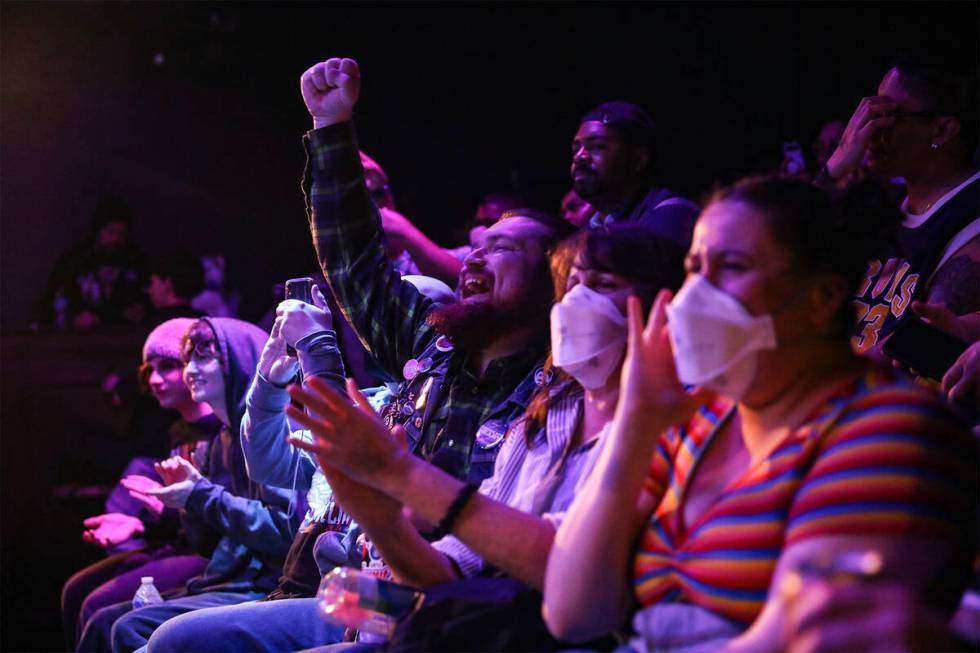
“It’s almost contagious, that energy,” Malott says. “It’s such a primal, human feeling to want to, like, yell and flip off the bad guy. That’s such a cool relief for so many different types of people, especially anyone in the queer community or women or anyone that comes from a minority group where sometimes your voice isn’t allowed to be as full as it could be. It becomes a part of the show.”
Tonight’s card was another success, a near sell-out. Afterward, Malott wears a look somewhere between relief and exhaustion. He’ll take a couple of days off to decompress before getting to work on the next show. Then it starts all over again: calling sponsors, creating fliers, wrangling talent, developing storylines. He’s cut back on his graphic design work in order to devote more time to PrideStyle.
It’s hit him in the pocketbook, but it’s worth it, he says. He’s also taking PrideStyle on the road, working to turn the company into a regular touring attraction, having already made stops in San Francisco, San Diego and Seattle. He hopes to get to the point where they can put on two or three shows every month. For now, though, Malott allows himself a moment of reflection.
“It took almost 30 years to find where I felt like I fit in,” he says.
To think, this all began as a joke. A safe space for violence, lol.
And now he’s too tired to laugh. ◆








